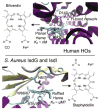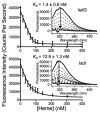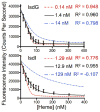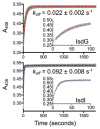Tight binding of heme to Staphylococcus aureus IsdG and IsdI precludes design of a competitive inhibitor
- PMID: 28401968
- PMCID: PMC5510889
- DOI: 10.1039/c7mt00035a
Tight binding of heme to Staphylococcus aureus IsdG and IsdI precludes design of a competitive inhibitor
Abstract
The micromolar equilibrium constants for heme dissociation from IsdG and IsdI reported in the literature call into question whether these enzymes are actually members of the iron-regulated surface determinant system of Staphylococcus aureus, which harvests heme iron from a host during infection. In order to address this question, the heme dissociation constants for IsdG and IsdI were reevaluated using three approaches. The heme dissociation equilibrium constants were measured using a UV/Vis absorption-detected assay analyzed with an assumption-free model, and using a newly developed fluorescence-detected assay. The heme dissociation rate constants were estimated using apomyoglobin competition assays. Analyses of the UV/Vis absorption data revealed a critical flaw in the previous measurements; heme is 99.9% protein-bound at the micromolar concentrations needed for UV/Vis absorption spectroscopy, which renders accurate equilibrium constant measurement nearly impossible. However, fluorescence can be measured for more dilute samples, and analyses of these data resulted in dissociation equilibrium constants of 1.4 ± 0.6 nM and 12.9 ± 1.3 nM for IsdG and IsdI, respectively. Analyses of the kinetic data obtained from apomyoglobin competition assays estimated heme dissociation rate constants of 0.022 ± 0.002 s-1 for IsdG and 0.092 ± 0.008 s-1 for IsdI. Based upon these data, and what is known regarding the post-translational regulation of IsdG and IsdI, it is proposed that only IsdG is a member of the heme iron acquisition pathway and IsdI regulates heme homeostasis. Furthermore, the nanomolar dissociation constants mean that heme is bound tightly by IsdG and indicates that competitive inhibition of this protein will be difficult. Instead, uncompetitive inhibition based upon a detailed understanding of enzyme mechanism is a more promising antibiotic development strategy.
Figures








Similar articles
-
IruO is a reductase for heme degradation by IsdI and IsdG proteins in Staphylococcus aureus.J Biol Chem. 2013 Sep 6;288(36):25749-25759. doi: 10.1074/jbc.M113.470518. Epub 2013 Jul 26. J Biol Chem. 2013. PMID: 23893407 Free PMC article.
-
Staphylococcus aureus haem oxygenases are differentially regulated by iron and haem.Mol Microbiol. 2008 Sep;69(5):1304-15. doi: 10.1111/j.1365-2958.2008.06363.x. Epub 2008 Jul 10. Mol Microbiol. 2008. PMID: 18643935 Free PMC article.
-
Heme degradation by Staphylococcus aureus IsdG and IsdI liberates formaldehyde rather than carbon monoxide.Biochemistry. 2013 May 7;52(18):3025-7. doi: 10.1021/bi400382p. Epub 2013 Apr 24. Biochemistry. 2013. PMID: 23600533 Free PMC article.
-
Structural biology of heme binding in the Staphylococcus aureus Isd system.J Inorg Biochem. 2010 Mar;104(3):341-8. doi: 10.1016/j.jinorgbio.2009.09.012. Epub 2009 Sep 26. J Inorg Biochem. 2010. PMID: 19853304 Review.
-
Intracellular metalloporphyrin metabolism in Staphylococcus aureus.Biometals. 2007 Jun;20(3-4):333-45. doi: 10.1007/s10534-006-9032-0. Epub 2007 Mar 27. Biometals. 2007. PMID: 17387580 Review.
Cited by
-
Spectroscopic Evidence for Electronic Control of Heme Hydroxylation by IsdG.Inorg Chem. 2019 Nov 18;58(22):15455-15465. doi: 10.1021/acs.inorgchem.9b02530. Epub 2019 Nov 6. Inorg Chem. 2019. PMID: 31693363 Free PMC article.
-
Structure of a Mycobacterium tuberculosis Heme-Degrading Protein, MhuD, Variant in Complex with Its Product.Biochemistry. 2019 Nov 19;58(46):4610-4620. doi: 10.1021/acs.biochem.9b00726. Epub 2019 Nov 6. Biochemistry. 2019. PMID: 31638374 Free PMC article.
-
An expandable, modular de novo protein platform for precision redox engineering.Proc Natl Acad Sci U S A. 2023 Aug;120(31):e2306046120. doi: 10.1073/pnas.2306046120. Epub 2023 Jul 24. Proc Natl Acad Sci U S A. 2023. PMID: 37487099 Free PMC article.
-
The affinity of MhuD for heme is consistent with a heme degrading function in vivo.Metallomics. 2018 Nov 14;10(11):1560-1563. doi: 10.1039/c8mt00238j. Metallomics. 2018. PMID: 30239544 Free PMC article.
-
The heme-sensitive regulator SbnI has a bifunctional role in staphyloferrin B production by Staphylococcus aureus.J Biol Chem. 2019 Jul 26;294(30):11622-11636. doi: 10.1074/jbc.RA119.007757. Epub 2019 Jun 13. J Biol Chem. 2019. PMID: 31197035 Free PMC article.
References
Publication types
MeSH terms
Substances
Grants and funding
LinkOut - more resources
Full Text Sources
Other Literature Sources
Molecular Biology Databases
Miscellaneous

